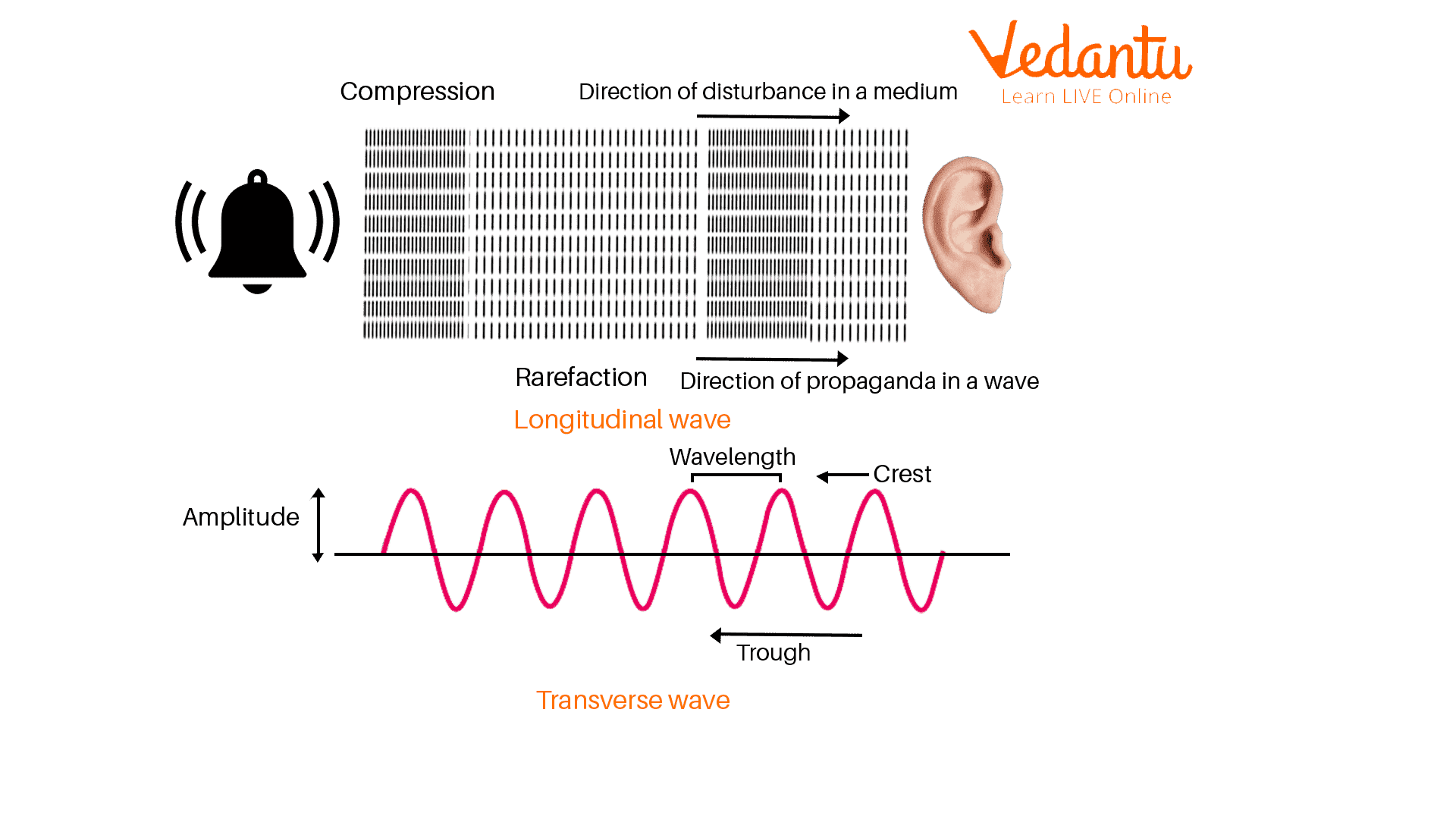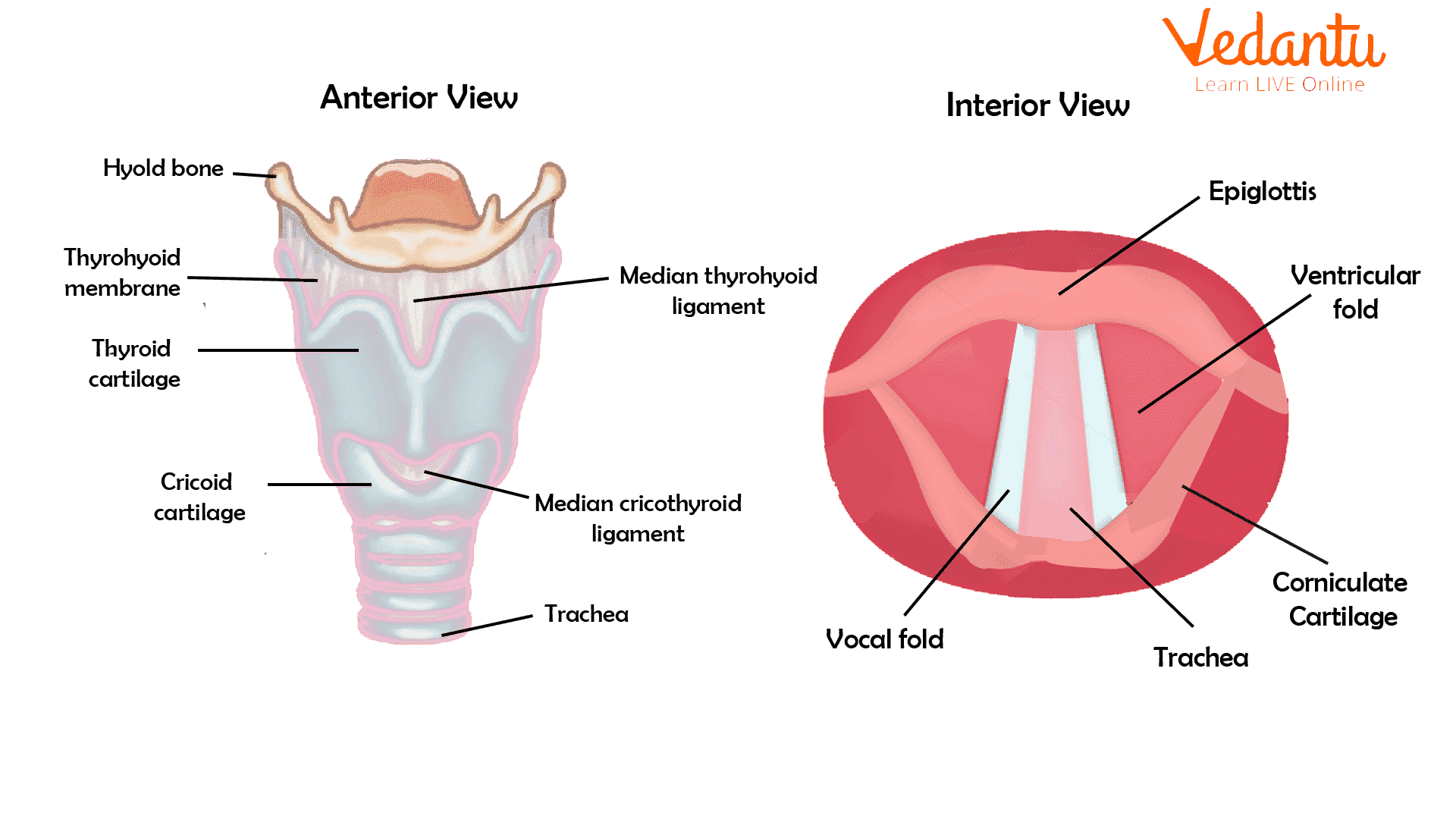




Key Concepts in Human Sound Production and Their Applications
Before we learn about how humans produce sound or sound produced by humans. First, let us try to understand the meaning and characteristics of sound waves. Any vibrating material is capable of producing sound. Hence sound is a form of energy produced by objects when they vibrate. The particles of the medium in which the body is vibrating also vibrate, and these vibrations propagate through that medium at a certain speed as waves. One important criterion for sound waves to propagate is that there has to be a medium always for its propagation. Sound cannot travel in a vacuum.
What are Sound Waves?
A sound wave is an arrangement of the disturbance brought about by energy moving through a medium (such as air or water) as it dissipates from the sound source. A bell ringing or someone's vocal cords are examples of objects that can act as the source of vibration. As a result of the object's vibration, nearby particles in the medium are also disturbed which further disturbs particles close to them, and so on. The term "sound wave" refers to the pattern of orderly disruption that results in an outward motion in a wave-like pattern that transmits sound energy across the medium, normally in all directions but with decreasing strength as it goes further away from the source object.
Characteristics of Sound Waves
Amplitude: The highest vertical displacement of the wave from its mean position is referred to as amplitude.
Wavelength: wavelength is defined as the distance between two consecutive crests or troughs in a sound wave
Frequency: The number of waves that pass a fixed point in a unit of time is known as frequency. SI unit is hertz(Hz). The range of frequencies that the human ear can detect is 20 Hz to 20 kHz.
Time Period: A sound wave's time period is the length of time needed to complete one wave cycle.
Velocity: The speed of a sound wave, measured in metres per second, informs us how quickly the wave is travelling. It measures the distance travelled by a wave in unit seconds.
Since sound travels through a medium, it is a longitudinal wave made up of compressions and rarefactions.

Longitudinal and Transverse Wave
Sound Produced by Humans: Process
Generally speaking, when an object vibrates and produces sound, the air molecules nearby are struck, which then causes the molecules next to them to be hit, and so on. A sequence of collisions causes a sound wave to travel across the medium.
Humans use the larnyx, commonly referred to as the speech box, to produce sound. On top of our throat's windpipe is where the voice box is located.
The human voice box has two ligaments called the vocal cords. Sound is produced by the vocal cords' waves.
The vocal cords are attached to muscles that may change the tension on or stretching of the cords as well as the distance between them. The muscles of the vocal cords are completely relaxed, which causes them to divide and loosen, enabling air from the lungs to flow into them quietly.
The two vocal cords are widely apart while we are not speaking or singing. The muscles in our vocal cords tighten and close the two vocal cords together when we want to communicate, leaving just a tiny slit between them. The lungs produce a stream of air that travels between the two vocal cords.
The air causes the vocal cords to vibrate. And the voice chords' vibrations are what create the sound. Our vocal cords physically vibrate when we speak or sing. The vibration of the vocal cords brought on by the expulsion of air is what creates vocal sounds. The frequency of the human voice: female voice has a frequency range of about 165 - 255 Hz while the male voice has a frequency range of about 85 - 155 Hz.
Mechanism of Human Voice Production
The three components that make up the human voice-producing system are as follows:
Lungs: These are the air-filled organs present on both sides of the chest and are protected by the ribcage. Anything that produces sound requires an energy source. The air that is exhaled from our lungs supplies the energy for human speech sounds.
Articulators: The vocal tract is divided into many components, each of which is essential for producing speech. These components, known as articulators, are what enable speech sounds. The tongue, upper and lower lips, gums and teeth, and the glottis are a few examples of articulators.
Larynx (Voice Box of Human Body): The voice/sound box is also known as the larynx. It is responsible for voice production. The anterior neck region contains the larynx. The larynx has two vocal cords and is located at the top of the trachea, allowing air to travel through it. Every time they are in close proximity, the vocal cords make a sound, which is subsequently followed by sound vibration when air travels through them. And it is these vibrations that create the sound wave for our voice.
The "Adam's apple" refers to the vocal folds that are affixed to the biggest piece of throat cartilage inside the voice box. The vocal cords should vibrate synchronously, symmetrically, and constantly to provide a clear sound while avoiding harshness. The sound pitch is determined by the vibration rate. The following might be the causes of a harsh voice:
Vocal folds don't completely close, vibrating in an uneven way.
Joints between muscles and the vocal cords may cause the chords to be stiff or loose. The kind and quality of voice differ depending on whether the vocal cords are loose and thick or tight and thin.

Larynx
Important Questions
1. What is the meaning of the term sound?
Ans: Sound is an energy type that travels like a wave through a medium. It is produced when the objects vibrate.
2. What is an important requirement for the propagation of sound waves?
Ans: Unlike light waves, sound waves cannot travel through a vacuum and the sound waves always require a medium (solids, liquids, or gases) for their propagation.
Summary
Sound is an externally propagated disruption of matter (a pressure wave). The perception of sound is called hearing. The medium and its condition affect the speed of sound. Sound waves travel faster through a solid medium compared to a liquid or gaseous medium. A change in a sound's apparent frequency brought on by motion, either of the source or the observer, is known as the Doppler effect. The Doppler shift is the name given to the actual change in frequency.
Practice Questions
1. How is the sound produced?
By vibration of objects
By movement of air
By movement water
None of the Above
2. The larynx is also called
Soundbox
Speech box
Only a
Both a and b
Answers:
(a)
(d)
FAQs on How Do Humans Produce Sound?
1. How do humans produce the sound of their voice?
Humans produce sound using the larynx, also known as the voice box. When we speak, air from our lungs is pushed through two small bands of muscle inside the larynx called the vocal cords. This rush of air makes the vocal cords vibrate, and these vibrations create the sound of our voice.
2. What is the voice box and where is it located in the body?
The voice box, or larynx, is the organ responsible for producing sound. It is located in the throat at the very top of the windpipe (trachea). You can often feel it as a hard lump in the front of your neck, which is sometimes called the Adam's apple, especially when it becomes more prominent in boys during puberty.
3. Why do the voices of men, women, and children sound so different?
The difference in voices is due to the size of the vocal cords, which affects the pitch of the sound. Here's a simple breakdown:
- Men generally have longer and thicker vocal cords, which vibrate more slowly, resulting in a lower-pitched voice.
- Women have shorter and thinner vocal cords, which vibrate faster, creating a higher-pitched voice.
- Children have the shortest vocal cords, leading to the highest-pitched voices.
4. How can we control the loudness and pitch of the sound we make?
We can control our voice in two main ways:
- Loudness: The loudness of our voice depends on the force of air pushed from the lungs. A stronger push of air creates a vibration with a larger amplitude, resulting in a louder sound.
- Pitch: The pitch is controlled by the muscles in the larynx. By making the vocal cords tighter or thinner, we increase their frequency of vibration, producing a higher pitch. Relaxing them does the opposite.
5. What is the key difference between a sound considered music and one considered noise?
The main difference lies in the nature of the sound waves. Music consists of sounds created by regular, patterned vibrations that are typically pleasant to hear. In contrast, noise is produced by irregular, random vibrations that are often perceived as unpleasant or jarring.
6. Could you hear someone speaking on the moon? Explain why.
No, you could not hear someone speaking on the moon. Sound requires a medium (like air, water, or a solid) to travel because it moves as a vibration through particles. The moon is in space, which is a vacuum—it has no air or other particles to carry the sound vibrations from the speaker to your ear.
7. How is the way a guitar produces sound similar to how our vocal cords work?
A guitar string and our vocal cords both produce sound through vibration. The comparison is quite direct:
- Pitch: Tightening a guitar string makes it vibrate faster and produce a higher pitch, just like tightening our vocal cords.
- Loudness: Plucking a guitar string harder creates a louder sound, just as pushing more air past our vocal cords makes our voice louder.






















